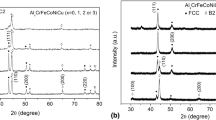Abstract
This paper outlines the results of an experimental study of the influence of high hydrostatic pressure on the abrasive wear of hard-alloy materials based on tungsten carbide (~90% WC ± 10% Co), as well as alloys based on iron with high contents of chromium. A specially developed setup has been described in the paper that makes it possible to test materials under the hydrostatic pressure of up to 250 MPa at different friction speeds. An investigation of the surfaces of samples using the Scanning Electron Microscopy method has revealed that the main damage of alloy surface occurs due to the delamination and spalling of hard particles. It has been revealed that the hydrostatic pressure significantly influences the wear rate of the investigated materials. When the pressure increases to 200 MPa, the wear of materials with high contents of chromium increases seven times, while for the material based on tungsten carbide, it increases twice.
Similar content being viewed by others
References
Strel’nikov, Yu.A., Friction in the contact interaction of surfaces under hydrostatic pressure conditions, Cand. Sci. (Tech.) Dissertation, Tver, 2010.
Bridgman, P.W., Studies in Large Plastic Flow and Fracture with Special Emphasis on the Effects of Hydrostatic Pressure, London: McGraw-Hill, 1952.
Kragel’skii, I.V., Dobychin, M.N., and Kombalov, V.S., Osnovy raschetov na trenie i iznos (Basic Calculations of Friction and Wear), Moscow: Mashinostroenie, 1977.
Bartenev, G.M. and Lavrent’ev, V.V., Trenie i iznos polimerov (Friction and Wear of Polymers), Leningrad: Khimiya, 1972.
Deryagin, B.V., Krotova, N.A., and Smilga, V.P., Adgeziya tverdykh tel (Adhesion of Solids), Moscow: Nauka, 1976.
Sosnovskiy, L.A., Tribo-Fatigue: Wear-Fatigue Damage and Its Prediction (Foundations of Engineering Mechanics), New York: Springer-Verlag, 2005.
Goryacheva, I.G., Mekhanika friktsionnogo vzaimodeistviya (Mechanics of Friction Interaction), Moscow: Nauka, 2001.
Ibatullin, I.D., Kinetika ustalostnoi povrezhdaemosti i razrusheniya poverkhnostnykh sloev: monografiya (Kinetics of Fatigue Damage and Destruction of Surface Layers: Monograph), Samara: Samarsk. Gos. Tekh. Univ., 2008.
Gladkovskii, V.A., The effect of hydrostatic pressure on the hardness of carbon steel, Fiz. Met. Metalloved., 1956, vol. 3, no. 1, pp. 183–184.
Author information
Authors and Affiliations
Corresponding author
Additional information
Original Russian Text © V.V. Mishakin, S.N. Verichev, E.N. Razov, 2017, published in Trenie i Iznos, 2017, Vol. 38, No. 4, pp. 328–334.
About this article
Cite this article
Mishakin, V.V., Verichev, S.N. & Razov, E.N. Investigation of the influence of high hydrostatic pressure on the abrasive wear of hard-alloy materials. J. Frict. Wear 38, 286–291 (2017). https://doi.org/10.3103/S1068366617040110
Received:
Published:
Issue Date:
DOI: https://doi.org/10.3103/S1068366617040110



